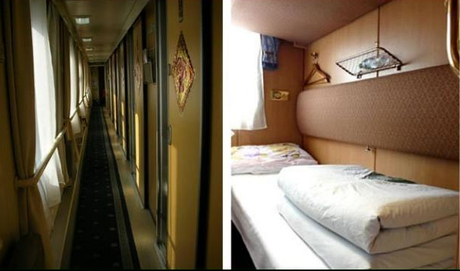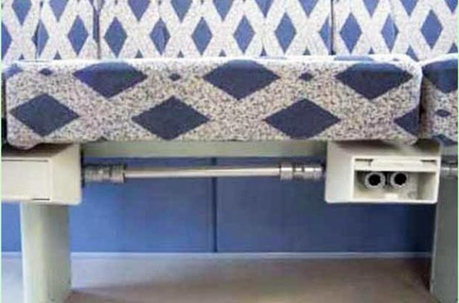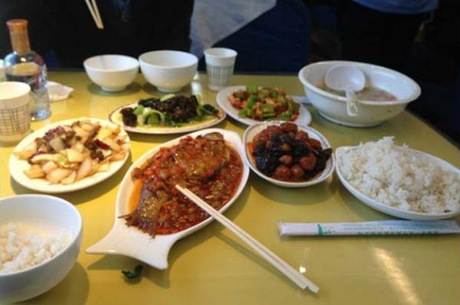Traveling to Tibet is an adventure, and traveling by train is an even bigger one. Train to Tibet leave from seven major cities in China, most of the trains run every day, both ways. The railway lines from mainland China all run through the station at Xining, the start of the official Qingzang Railway, and then climb to the high-altitude Qinghai-Tibetan Plateau via Golmud, where the real ascent starts.
All of the Tibet trains are relatively modern, and have surprisingly excellent facilities. They are both comfortable and clean, and the staff on all of the trains are friendly and helpful at all times. The trains have three different ticket classes – Soft sleeper berths, hard sleeper berths, and hard seats – and all trains have limited medical facilities, which normally include a nurse and often a doctor, in case of any medical emergencies caused by Acute Mountain Sickness (AMS), or altitude sickness, as it is more commonly known.
Facilities in soft sleeper
The soft sleeper cabins on the train to Tibet are the first-class accommodation, which afford the most comfort and privacy for the long trip to Lhasa. On each train there are normally two carriages with soft sleeper facilities, and each has 32 compartments, making a total of 64 soft sleeper cabins. Each cabin has four beds, two lower bunks and two fold-down upper bunks. The advantage of the soft sleeper over the hard sleeper is the lockable door on each cabin and fewer travelers in the same cabin, which promises better privacy.

Soft sleeper cabin
Facilities in hard sleeper
The hard sleeper cabins on the train are the second best accommodations, and there are normally as many as eight carriages with hard sleeper cabins, each containing around ten cabins. Each compartment has 6 berths, on three levels, and are much less costly than the soft sleepers.Hard sleeper berths are more readily available, with more berths on each train, and it is often easier to get a hard sleeper berth than a soft sleeper is. The name “hard sleeper” is also a misnomer, since the beds are not really “hard”. All berths have a soft mattress and pillows, and are just as comfortable as the soft sleeper berths.
The berths are also around 30 inches wide, but are a little shorter at only five feet eleven inches long. Still enough room for the average traveler though, so it will not be cramped unless you are a lot more than six feet tall. Vertical space is normally the problem in the hard sleepers. There is around 30 inches between the lower and middle berths, 28 inches between middle and upper, and only 26 inches of headroom on the upper berth. So watch your head when sitting up in the berths. Access to each of the higher berths is gained by using the ladders at the outer end of each cabin.
There is also no door on the hard sleeper cabins, so it is open to the corridor outside. While there is very little crime on the trains due to excellent staff and the security patrol on all trains, it is still not advisable to leave valuable items in the cabin when you leave. Outside each cabin, in the corridor, are two pull-down seats and a large window for watching the landscape as the train speeds across the plateau.
Again, larger luggage can be stored under the lower bunks, while smaller bags can go on the rack above the cabin’s window. Hard sleeper berths are less expensive than the soft sleepers, but not as cheap as the seat tickets, and it is not recommended to buy a seat ticket, especially for the longer journey’s from gateway cities such as Beijing and Shanghai. Hard sleeper cabins and carriages are often more crowded than soft sleeper carriages, so if noise is an issue, the soft sleeper is probably better.
Oxygen outlets in the hard sleeper carriages are in the corridors outside the cabins, and are set into the wall of the carriage next to each pair of seats.
One of the main drawbacks to the hard sleeper cabins is that during the day, other passengers in your cabin will sit on the lower bunks to talk, play cards, read books, etc. This is normal on trains in China, and it is expected to let them to do this. If you wish for more privacy during your trip, the soft sleeper berth is the better option.

Oxygen supply outlet
Facilities in hard seat
The cheapest way to travel to Tibet is the hard seat ticket. While the name is another misnomer, and the seats are not really hard, they are not ideal for the long journey to Lhasa. Each carriage has around 98 seats, and there are normally four carriages on each train. Seats are set in a facing position, with a small table between, and are in rows of five, with two seats on one side of the carriage and three on the other.
Each seat has an individual oxygen outlet underneath, in case passengers have problems with altitude sickness, and there are luggage racks above the windows for storing bags and suitcases.

As the cheapest option for travel to Tibet, the seat tickets are normally used by locals traveling back to Tibet, and the carriages are often overcrowded. The seats are barely large enough for the small Asian frame, and for larger people, would be extremely uncomfortable. Some trains also allow standing passengers in the seating carriages, who normally pay a reduced cost since they do not have a seat. Standing passengers can spend the journey sitting in the dining car, while it is open. Standing is definitely not an option to recommend.
Other facilities
Aside from the sleeping facilities on the trains, each train is fully equipped with a dining cart and restaurant, where you can get a choice of both Tibetan and Chinese foods, as well as snacks and packaged meals, soft or alcoholic drinks, and tea or coffee. The cart usually comes around the carriages at meal times, and has box meals as well as snacks, drinks, etc.

Only Chinese food is offered onboard the Tibet trains
